NCERT Solutions | Class 6 Maths Chapter 10 | Mensuration

CBSE Solutions | Maths Class 6
Check the below NCERT Solutions for Class 6 Maths Chapter 10 Mensuration Pdf free download. NCERT Solutions Class 6 Maths were prepared based on the latest exam pattern. We have Provided Mensuration Class 6 Maths NCERT Solutions to help students understand the concept very well.
NCERT | Class 6 Maths
| Book: | National Council of Educational Research and Training (NCERT) |
|---|---|
| Board: | Central Board of Secondary Education (CBSE) |
| Class: | 6th |
| Subject: | Maths |
| Chapter: | 10 |
| Chapters Name: | Mensuration |
| Medium: | English |
Mensuration | Class 6 Maths | NCERT Books Solutions
NCERT Solutions for Class 6 Maths Chapter 10 Mensuration Exercise 10.1
Ex 10.1 Class 6 Maths Question 1.
Find the perimeter of each of the following figures: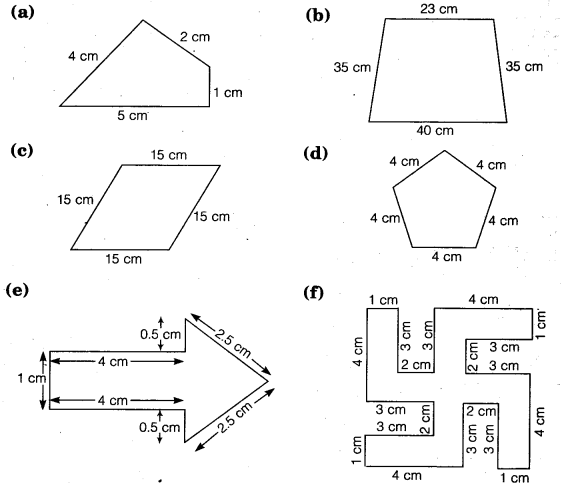
Solution:
(a) Perimeter = the sum of the lengths of sides= 5 cm +1 cm +2 cm + 4 cm = 12cm
(b) Perimeter = the sum of the lengths of sides
= 40 cm +35 cm + 23 cm +35 cm = 133 cm
(c) Perimeter = 4x the length of one side
= 4 x 15 cm = 60 cm
(d) Perimeter = 5 x the length of one side
4 = 5 x 4 cm = 20 cm
(e) Perimeter = the sum of the lengths of sides
= 4 cm + 0.5 cm + 2.5 cm + 2.5 cm + 0.5 cm + 4 cm + 1 cm = 15 cm
(f) Perimeter = the sum of the lengths of sides
= 4 cm + 3 cm + 2 cm + 3 cm + 1 cm + 4 cm + 3 cm + 2 cm + 3 cm + 1 cm + 4 cm + 3 cm + 2 cm +3 cm +1 cm + 4 cm + 3 cm + 2 cm + 3 cm + 1 cm = 52 cm
Ex 10.1 Class 6 Maths Question 2.
The lid of a rectangular box of sides 40 cm by 10 cm is sealed all round with tape. What is the length of the tape required?Solution:
Length of the tape required= Perimeter of the lid of a rectangular box = 2 x ( length + breadth)
= 2 x (40 cm +10 cm)
= 2 x 50 cm = 100 cm or 1 m
Ex 10.1 Class 6 Maths Question 3.
A table-top measures 2 m 25 cm by 1 m 50 cm. What is the perimeter of the table-top?Solution:
Perimeter of the table-top= 2 x (length + breadth)
= 2 x (2 m 25 cm +1 m 50 cm)
= 2 x (3 m 75 cm)
= 2 x 3.75 m = 7.50 m
Ex 10.1 Class 6 Maths Question 4.
What is the length of the wooden strip required to frame a photograph of length and breadth 32 cm and 21 cm, respectively?Solution:
The length of the wooden strip required to frame a photograph is the perimeter of the photograph.Perimeter of the photograph = 2 x (length + breadth)
= 2 x (32 cm +21 cm)
= 2 x 53 cm = 106 cm
∴ The length of the wooden strip required is 106 cm.
Ex 10.1 Class 6 Maths Question 5.
A rectangular piece of land measures 0.7 km by 0.5 km. Each side is to be fenced with 4 rows of wires. What is the length of the wire needed?Solution:
We have to cover 4 times the perimeter of the land measuring 0.7 km by 0.5 km.∴ Total length of wire required is 4 times its perimeter.
Perimeter of the land = 2 x (length + breadth)
= 2x (0.7 km+0.5 km)
= 2 x 1.2 km = 2.4 km
∴ Total length of wire required = 4 x 2.4 km = 9.6 km
Ex 10.1 Class 6 Maths Question 6.
Find the perimeter of each of the following shapes:(a) A triangle of sides 3 cm, 4 cm and 5 cm.
(b) An equilateral triangle of side 9 cm.
(c) An isosceles triangle with equal sides 8 cm each and third side 6 cm.
Solution:
(a) Perimeter = the sum of the sides= 3 cm + 4 cm + 5cm = 12 cm
(b) Perimeter = 3 x the length of one side
= 3 x 9 cm = 27 cm
(c) Perimeter = the sum of the lengths of the sides
= 8 cm + 8 cm + 6 cm = 22 cm
Ex 10.1 Class 6 Maths Question 7.
Find the perimeter of a triangle with sides measuring 10 cm, 14 cm and 15 cm.Solution:
Perimeter of the triangle = the sum of the lengths of its sides= 10 cm + 14 cm + 15 cm = 39 cm
Ex 10.1 Class 6 Maths Question 8.
Find the perimeter of a regular hexagon with each side measuring 8 m.Solution:
A regular hexagon has 6 sides, so its perimeter= 6 x length of its one side = 6 x 8 m
= 48 m
Ex 10.1 Class 6 Maths Question 9.
Find the side of the square whose perimeter is 20 m.Solution:
Perimeter = 20 mA square has 4 equal sides, so we can divide the perimeter by 4 to get the length of one side.
One side of the square = 20 m + 4 = 5m
Ex 10.1 Class 6 Maths Question 10.
The perimeter of a regular pentagon is 100 cm. How long is its each side?Solution:
Perimeter = 100 cmA regular pentagon has 5 equal sides, so we can divide the perimeter by
5 to get the length of one side
∴ length of one side = 100 cm + 5 = 20 cm
Ex 10.1 Class 6 Maths Question 11.
A piece of string is 30 cm long. What will be the length of each side if the string is used to forms
(a) a square?
(b) an equilateral triangle?
(c) a regular hexagon?
Solution:
(a) Perimeter = Length of the string = 30 cmA square has 4 equal sides, so we can divide the perimeter by 4 to get the length of one side.
One side of the square = 30 cm + 4 = 7.5 cm
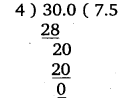
(b) Perimeter = Length of the string = 30 cm
An equilateral triangle has 3 equal sides, so we can divide the perimeter by 3 to get the length of one side.
∴ One side of an equilateral triangle = 30 cm ÷ 3 = 10 cm
(c) Perimeter = Length of the string = 30 cm
A regular hexagon has 6 equal sides, so we can divide the perimeter by
6 to get the length of one side.
One side of a regular hexagon = 30 cm + 6 = 5 cm
Ex 10.1 Class 6 Maths Question 12.
Two sides of a triangle are 12 cm and 14 cm. The perimeter of the triangle is 36 cm. What is its third side?Solution:
Let ABC be the given triangle such that AB =12 cm, BC = 14 cm and its perimeter = 36 cm.i.e., AB + BC + CA = 36 cm
or 12 cm + 14 cm + CA = 36 cm
or 26 cm + CA = 36 cm
or CA =36 cm – 26 cm = 10 cm
∴ The third side of triangle is 10 cm.
Ex 10.1 Class 6 Maths Question 13.
Find the cost offencing a square park ofside 250 mat the rate of ? 20 per metre.Solution:
Side of the square park = 250 m∴ Perimeter of the square park
= 4 x side
= 4 x 250 m = 1000 m
∴ Cost of fencing = ₹ (1000 x 20)
= ₹ 20000
Ex 10.1 Class 6 Maths Question 14.
Find the cost of fencing a rectangular park of length 175 m and breadth 125 m at the rate of? 12 per metre.Solution:
Length of the rectangular park = 175 m Breadth of the rectangular park 125 m .-. Perimeter of the park = 2 x (length + breadth)= 2 x (175m + 125m)
= 2 x 300 m = 600 m
∴ Cost of fencing = ₹ (600 x 12) = ₹ 7200
Ex 10.1 Class 6 Maths Question 15.
Sweety runs around a square park of side 75 m. Bulbul runs around a rectangular park with length 60 m and breadth 45 m. Who covers less distance?Solution:
The distance each girl covers in one round is the same as the perimeter of the respective field. Therefore, the distance that Sweety covers in one round= 4 x side
= 4 x 75 m = 300 m
Also, the distance that Bulbul covers in one round
= 2 x (length + breadth)
= 2 x (60 m + 45 m)
= 2 x 105 m = 210 m
This shows that Bulbul covers less distance than Sweety.
Ex 10.1 Class 6 Maths Question 16.
What is the perimeter of each of the following figures? What do you infer from the answer?

Solution:
(a) Perimeter = 4 x side= 4 x 25 cm
= 100 cm
(b) Perimeter = 2 x (length + breadth)
= 2 x (40 cm +10 cm)
= 2 x 50 cm = 100 cm
(c) Perimeter = 2 x (length + breadth)
2 x (30 cm +20 cm)
= 2 x 50 cm = 100 cm
(d) Perimeter = 30 cm +30 cm +40 cm = 100 cm
Thus, we observe that the perimeter of each figure is 100 cm i.e., they have equal perimeters.
Ex 10.1 Class 6 Maths Question 17.
Avneet buys 9 square paving slabs, each with a side of 1/2 m. He lays them in the form of a square.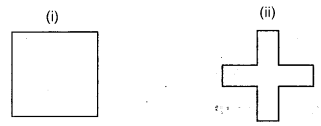
(a) What is the perimeter of his arrangement [Fig. (i)]?
(b) Shari does not like his arrangement. She gets him to lay them out like a cross. What is the perimeter of her arrangement [Fig. (ii)]?
(c) Which has greater perimeter?
(d) Avneet wonders if there is a way of getting an even greater perimeter. Can you find a way of doing this? (The paving slabs must meet along complete edges i.e. they cannot be broken.)
Solution:
(a) In case of Avneet’s arrangement: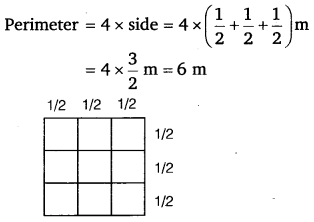
(b) In case of Shari’s arrangement:
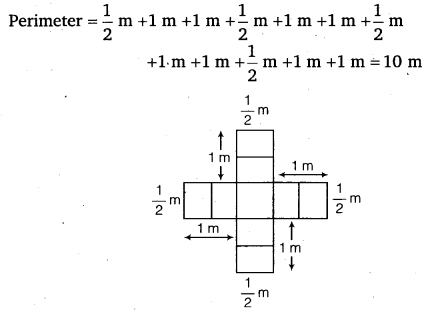
(c) Clearly, perimeter in case of Shari is greater.
(d) Yes, there is a way shown in the figure in which we get a greater perimeter

Perimeter = 2 x (9 + 1) units = 2 x 10 units = 20 units
NCERT Solutions for Class 6 Maths Chapter 10 Mensuration Exercise 10.2
Ex 10.2 Class 6 Maths Question 1.
Find the areas of the following figures by counting square:
Solution:
Placing these figures on the centimetre square, we have(a) Full squares = 9
∴ Area covered by the figure = 9 x 1 sq. cm = 9 sq. cm
(b) Full squares = 5
∴ Area covered by the figure = 5 x 1 sq. cm = 5 sq. cm
(c) Full squares = 2
Half squares = 4
∴ Area covered by the figure \(\left( 2\times 1+4\times \frac { 1 }{ 2 } \right) \) sq. cm
= (2 + 2) sq cm = 4 sq. cm
(d) Full squares = 10
∴ Area covered by the figure = 10 x 1 sq. cm = 10 sq. cm
(e) Full squares = 10
∴ Area covered by the figure = 10 x 1 sq. cm = 10 sq. cm
(f) Full squares = 2
Half squares = 4
∴ Area covered by the figure = \(\left( 2\times 1+4\times \frac { 1 }{ 2 } \right) \) sq. cm
= (2 + 2)sq. cm = 4 sq. cm
(g) Full squares = 4
Half squares = 4
∴ Area covered by the figure = \(\left( 2\times 1+4\times \frac { 1 }{ 2 } \right) \) sq. cm
= (4 + 2)sq. cm = 6 sq. cm
(h) Full squares = 5
∴ Area covered by the figure = 5 x 1 sq. cm
= 5 sq. cm
(i) Full squares = 9
∴ Area covered by the figure = 9 x 1 sq. cm
= 9 sq. cm
(j) Full squares = 2
Half squares = 4
∴ Area covered by the figure = \(\left( 2\times 1+4\times \frac { 1 }{ 2 } \right) \) sq. cm
= (2 + 2)sq. cm = 4 sq. cm
(k) Full squares = 4
Half squares = 2
∴ Area covered by the figure = \(\left( 4\times 1+2\times \frac { 1 }{ 2 } \right) \) sq. cm
= (4 + 1)sq. cm = 5 sq. cm
(l) Full squares = 4
More than half squares = 3
Half square = 2
∴ Area covered by the figure = \(\left( 4\times 1+3\times 1+2\times \frac { 1 }{ 2 } \right) \) sq. cm
= (4 + 3 + 1)sq. cm
= 8 sq. cm
(m) Full squares = 7
More than half squares = 7
Half square = 0
∴ Area covered by the figure = \(\left( 7\times 1+7\times 1+0\times \frac { 1 }{ 2 } \right) \) sq. cm
= (7 + 7 + 0)sq. cm
= 14 sq. cm
(n) Full squares = 10
More than half squares = 8
Half square = 0
∴ Area covered by the figure = \(\left( 10\times 1+8\times 1+0\times \frac { 1 }{ 2 } \right) \) sq. cm
= (10 + 8 + 0)sq. cm
= 18 sq. cm
NCERT Solutions for Class 6 Maths Chapter 10 Mensuration Exercise 10.3
Ex 10.3 Class 6 Maths Question 1.
Find the areas of the rectangles whose sides are:(a) 3 cm and 4 cm
(b) 12 m and 21 m
(c) 2 km and 3 km
(d) 2 m and 70 cm
Solution:
(a) Length of the rectangle = 4 cmBreadth of the rectangle = 3 cm
Area = Length x Breadth
= 4 cm x 3 cm
= 12 sq. cm
(b) Length of the rectangle = 21 m
Breadth of the rectangle = 12 m
Area = Length x Breadth
= 21 m xl2 m
= 252 sq. m.
(c) Length of the rectangle = 3 km
Breadth of the rectangle =2 km
Area = Length x Breadth
= 3 km x 2km
= 6 sq. km
(d) Length of the rectangle =2m = 2 x l00= 200 cm
Breadth of the rectangle = 70 cm
Area = Length x Breadth
= 200 cm x 70 cm
= 14000 sq. cm
Ex 10.3 Class 6 Maths Question 2.
Find the areas of the squares whose sides are:(a) 10 cm
(b) 14 cm
(c) 5 m
Solution:
(a) Side of the square = 10 cmArea = (side)2
= (10)2 sq. cm
= 100 sq. cm
(b) Side of the square = 14 cm
Area = (side)2
= (14)2 sq. cm
= 196 sq. cm
(c) Side of the square = 5 m
Area = (side)2
= (5)2 sq. m = 25sq. m
Ex 10.3 Class 6 Maths Question 3.
The length and breadth of three rectangles are as given below:(a) 9 m and 6 m
(b) 17 m and 3 m
(c) 4 m and 14 m
Which one has the largest area and which one has the smallest?
Solution:
In rectangle (a), Area = (9 x 6) sq. m= 54 sq. m
In rectangle (b), Area =(3 x 17) sq. m = 51 sq. m
In rectangle (c), Area = (4 x 14) sq. m = 56 sq. m
Clearly, 56 > 54 > 51 i.e., 56 is the largest number and 51 is the smallest number.
∴ The rectangle (c) has the largest area and the rectangle (a) has the smallest area.
Ex 10.3 Class 6 Maths Question 4.
The area of a rectangular garden 50 m long is 300 sq m. Find the width of the garden.Solution:
We use the formula A = l x b, where l is the length and b is the breadth of the rectangle in metre and its area in m2.Here, A = 300 m2, and l = 50 m
Therefore, 300 =50 x b [ ∵ A = l x b]
or \(b=\frac { 300 }{ 50 } =6\)
Hence the breadth (width) of the rectangle is 6 m.
Ex 10.3 Class 6 Maths Question 5.
What is the cost of tiling a rectangular plot of land 500 m long and 200 m wide at the rate of ₹ 8 per hundred sq. m?Solution:
Area of rectangular piece of land = 500 x 200 sq. m= 100000 sq. m
Cost of tiling the land at the rate of ₹ 8 per hundred sq. m
= ₹ \(\left( 100000\times \frac { 1 }{ 100 } \right) \) = ₹ 8000
Ex 10.3 Class 6 Maths Question 6.
A table-top measures 2 m by 1 m 50 cm. What is its area in square metres?Solution:
Length of table’s top = 2 mBreadth of table’s top = 1 m 50 cm = 1.50 m
∴ Area = Length x Breadth
= (2 x 1.50) sq m = 3 sq m
Ex 10.3 Class 6 Maths Question 7.
A room is 4 m long and 3 m 50 cm wide. How many square metres of carpet is needed to cover the floor of the room?Solution:
Length of the room = 4 mBreadth of the room = 3 m 50 cm = 3.50 m
Carpet needed to cover the floor of the room
= Area of the floor of the room
= Length x Breadth
= (4 x 3.50) sq. m = 14 sq. m
Ex 10.3 Class 6 Maths Question 8.
A floor is 5 m long and 4 m wide. A square carpet of sides 3 m is laid on the floor. Find the area of the floor that is not carpeted.Solution:
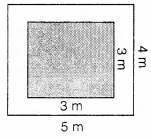
Area of the floor of the room = (5 x 4) sq. m
= 20 sq. m
Area of the carpet = (3 x 3) sq. m = 9 sq. m
Area of the floor not carpeted = (20 – 9) sq. m
= 11 sq. m
Ex 10.3 Class 6 Maths Question 9.
Five square flower beds each of sides 1 m are dug on a piece of land 5 m long and 4 m wide. What is the area of the remaining part of the land?Solution:
Area of the piece of land =(5 x 4) sq. m= 20 sq. m
Area of square flower bed =(1 x 1) sq. m
= 1 sq. m
Area of 5 such flower beds =(5 x 1) sq. m
= 5 sq. m
∴ Area of the remaining part of land
= (20 – 5) sq. m = 15 sq. m
Ex 10.3 Class 6 Maths Question 10.
By splitting the following figures into rectangles, find their areas (The measures are given in centimetres).
Solution:
(a) Let the figure may be divided into rectangles marked as A, B, C etc. Area of rectangle (A) = (3 x 3) sq. cm = 9 sq. cm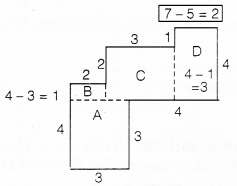
Area of rectangle (B) = (1 x 2) sq. cm = 2 sq. cm
Area of rectangle (C) = (3 x 3) sq. cm = 9 sq. cm
Area of rectangle (D) = (4 x 2) sq. cm = 8 sq. cm
∴ The total area of the figure = (9 + 2 + 9 + 8) sq. cm = 28 sq. cm
(b) Let the figure may be divided into rectangle marked as shown.
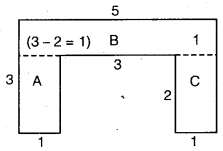
Area of rectangle (A) = (2 x 1) sq cm = 2 sq cm
Area of rectangle (B) = (5 x 1) sq cm = 5 sq cm
Area of rectangle (C) = (2 x 1) sq cm = 2 sq cm
∴ Total area of the figure = (2 + 5 + 2) sq cm = 9 sq cm
Ex 10.3 Class 6 Maths Question 11.
Split the following shapes into rectangles and find their areas. (The measures are given in centimetres)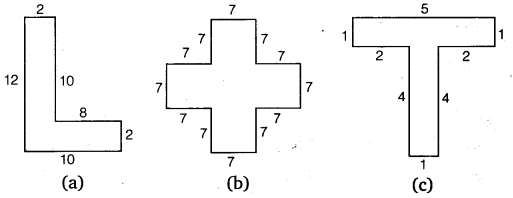
Solution:
(a) Splitting the given shape into rectangles as marked A and B.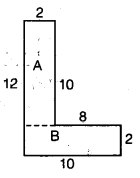
Area of the rectangle (A) = (10 x 2) sq cm
= 20 sq cm
Area of the rectangle (B) = (10 x 2) sq cm
= 20 sq cm
∴ Total area of given shape = (20 +20) sq cm
= 40 sq cm
(b) Splitting the given shape into five squares each of side 7 cm.
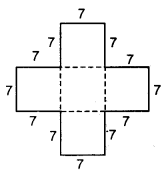
Area of the given shape
= 5 x Area of one square of side 7 cm = 5 x (7 x 7) sq. cm
= (5 x 49)sq cm 7
= 245 sq cm
(c) Splitting the given shape into two rectangles named A and B. Area of rectangle (A) = (5 x 1) sq cm = 5 sq cm
Area of rectangle (B) = (4 x 1) sq cm = 4 sq cm
∴ Total area of given shape = (5 + 4) sq cm = 9 sq cm
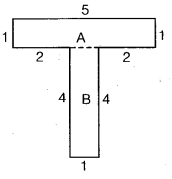
Ex 10.3 Class 6 Maths Question 12.
How many tiles whose length and breadth are 12 cm and 5 cm, respectively will be needed to fit in a rectangular region whose length and breadth are respectively:(a) 100 cm and 144 cm
(b) 70 cm and 36 cm
Solution:
(a) Area of the rectangular region= (100 x 144) sq cm
= 14400 sq cm
Area of one tile = (5 x 12) sq cm
= 60 sq cm

(b) Area of the rectangular region
= (70 x 36) sq cm
= 2520 sq cm

NCERT Class 6 Maths
Class 6 Maths Chapters | Maths Class 6 Chapter 10
NCERT Solutions for Class 6 Maths
NCERT Solutions of Maths Class 6 Chapter-wise
Chapter-wise NCERT Solutions for Class 6 Maths
-
NCERT Solutions For Class 6 Maths Chapter 1 Knowing Our Numbers
NCERT Solutions For Class 6 Maths Chapter 2 Whole Numbers
NCERT Solutions For Class 6 Maths Chapter 3 Playing With Numbers
NCERT Solutions For Class 6 Maths Chapter 4 Basic Geometrical Ideas
NCERT Solutions For Class 6 Maths Chapter 5 Understanding Elementary Shape
NCERT Solutions For Class 6 Maths Chapter 6 Integers
NCERT Solutions For Class 6 Maths Chapter 7 Fractions
NCERT Solutions For Class 6 Maths Chapter 8 Decimals
NCERT Solutions For Class 6 Maths Chapter 9 Data Handling
NCERT Solutions For Class 6 Maths Chapter 10 Mensuration
NCERT Solutions For Class 6 Maths Chapter 11 Algebra
NCERT Solutions For Class 6 Maths Chapter 12 Ratio and Proportion
NCERT Solutions For Class 6 Maths Chapter 13 Symmetry
NCERT Solutions For Class 6 Maths Chapter 14 Practical Geometry
NCERT Solutions for Class 6 to 12
-
NCERT Solutions for Class 6 All Subjects
NCERT Solutions for Class 7 All Subjects
NCERT Solutions for Class 8 All Subjects
NCERT Solutions for Class 9 All Subjects
NCERT Solutions for Class 10 All Subjects
NCERT Solutions for Class 11 All Subjects
NCERT Solutions for Class 12 All Subjects

Post a Comment
इस पेज / वेबसाइट की त्रुटियों / गलतियों को यहाँ दर्ज कीजिये
(Errors/mistakes on this page/website enter here)